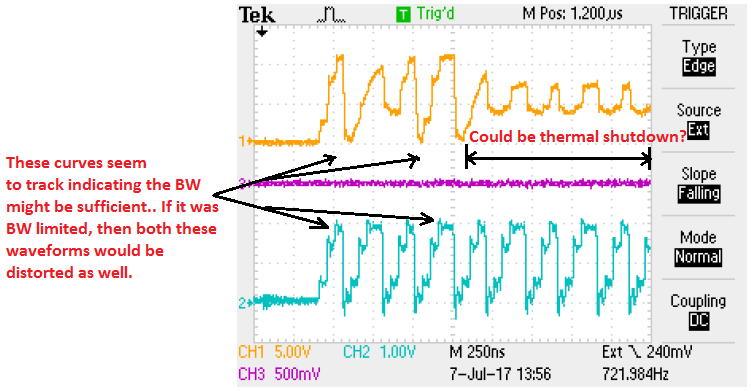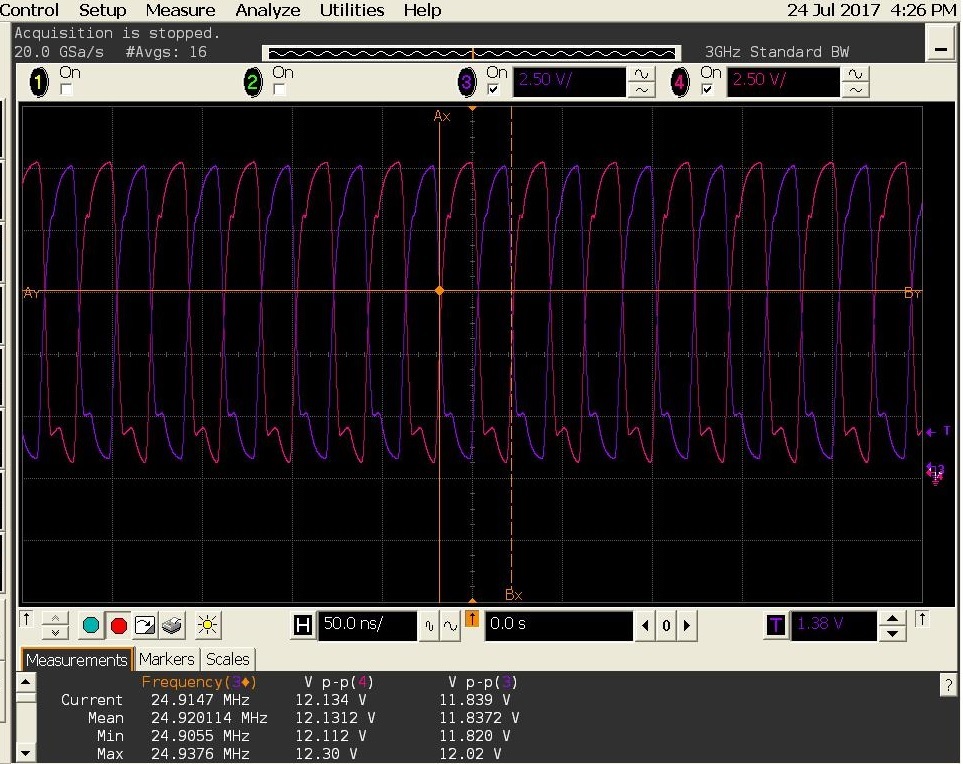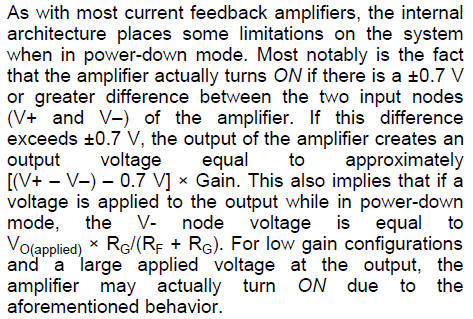Other Parts Discussed in Thread: LMH6739, THS3092, THS6012EVM, THS6012, THS3001, THS3096
My customer is seeing the following issues with the THS6002:
I'm using this part for its high-speed/bandwidth current FB capabilities, but not for an ADSL application. I targeted this part for its "quad" packaging as I need 64-channels of analog output in a minimum footprint. I also ran several p-spice sims to evaluate various parts for this challenging application.
After implementing the design, I'm seeing strange "recovery" type behaviors which are triggered by full-scale negative going steps (only) that are followed by an approximate 2 usec period of random reduced amplitude output. The part exhibits no problem with similar full-scale positive edge step responses.
I am using the parts (trying) to create a uni-polar 0-to-12V output with a small (hi-Z) load. I'm running them with a 1.2K FB resistor in a 6 gain configuration to achieve a 12V output from a 2V p-p input. The worst case signal input is effectively a 25 MHz square wave from a DAC running at 25 MHz clock rate.
Thinking the "negative only" behavior was perhaps a supply headroom issue, I increased the negative supply rail as far as -15V (initially designed for 15/-5V). The increased supply headroom has no affect on the strange behavior.
The 0-2V input waveform has some ringing (overshoot/undershoot) and a fast rise/fall time of approximately 2 nsec.
Is this asymmetrical behavior possibly due to some kind of internal saturation issue specific to the THS6002 device? What can I do to correct it?
Unfortunately, the circuitry is at my clients facility and I did not think to capture any scope trace pictures earlier that I can send you. It will be next week before I can do that.
I have attached schematics of both the source signal buffers and the amplifier circuits annotated with notes. I realize the whole configuration is far from ideal, but its what I was given (as a design consultant) to make system “speed improvements” on. I have provided a re-design of the video buffer cards as well as new amplifier cards that are arranged in two-card stacks with ribbon cable interconnects. Each card contains 32-channels of signal amplification.
Both the buffer and amplifier pcbs are 8-layer with all input/output signal traces on controlled impedance internal layers (stripline) between ground and power plane layers. In a rush to get the pcbs finished, I did not take the time to add plane layer cutouts around the amp input pins to minimize capacitance. Since the components were so close and traces so short, I gambled that wouldn’t be necessary.
Also, prior debug steps have included:
Temporary increase of decoupling (handheld on amp pins) – no observable changes noted.
Reduced FB resistor values (and gain) slightly – no improvement, actually made erratic response worse.
Maximized power supply headroom – no improvements noted.
Added stray capacitance on input pins (via fingers etc) – no observable changes noted.
The amp behavior doesn’t really look like an instability since its only associated with negative transitions? I would think a phase induced oscillation would be present all the time, instead of just on negative step responses? I have since noticed in the datasheet the 70ns “settling time” for 01%, and some rather low BW numbers for “full power” operation. Even these do not explain a 2 usec recovery time after a full-scale negative transition.
I have attached his schematics.
THS6002 Output Issues_THS6002 Amp Sch.pdf
THS6002 Output Issues_Video Buffer Input Sch.pdf
My question is whether he can set up a gain of 6 and still be able to meet the specifications in the data sheet. The only references to gain that are given are either 1x or 2x. Is he having a bandwidth issue when the fast negative signal appears on the input? The recovery time also seems odd, but there is nothing specified in the data sheet regarding the recovery from an over-voltage situation. He is driving the outputs near to the rail.
I am sorry I cannot provide a scope shot of this behavior right now, but I hoped that you might be able to diagnose the problem by just seeing the schematics and an explanation of the circuit.
Please let me know if you have additional questions for the customer.
Thanks for your help with this!
Richard Elmquist




